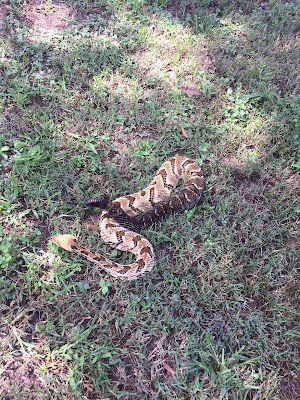 |
| Timber Rattler (Range throughout GA) |
Snake Aversion Training, also known as Snake Broke, is mandatory for my dogs. We hunt Montana in September and usually see several Prairie Rattlers every year. Then the weather cools for Wyoming, Oklahoma, South Dakota, North Dakota, and Arizona, New Mexico and snakes aren't so much a factor. However, January in New Mexico can have some pretty warm days and the Prairie Rattlers will come out of their holes to sun. At least they are a little sluggish that time of year. Snake Aversion Training is another tool in the box to keep our dogs safe when operating in snake habitat. Along with the training, I give my dogs the Red Rocks Biologics snake vaccine with a booster every year. Veterinarians in the West seem to be divided as to the efficacy of the vaccine. However, I've decided in favor of using it, based on subjective stories from guys whose dogs have been struck by venomous snakes. They think the recovery was shorter and the damage less after giving the vaccine. My question is: How would they know? That aside, I've chosen to use it.
 |
| Likely Candidate and her Lab |
We hired a professional in the local area. He is a certified reptile rescuer with the Georgia DNR. He travelled to Arizona one year to learn the technique from a Western Snake guy. I have no doubt his method works, I've had occasion to see it in action. Three years ago, in Montana on a hot day, I was hunting Pearl, my youngest female Brittany. As usual, we were moving through the grass looking for Sharptails and Hungarian Partridge (Huns). Pearl had just come in for some water and was moving away from me at an angle. She made a quick move to the left then right and continued on her way. As I approached the spot, I was still pondering the move, wondering what caused it- just as I stepped over a 5' Prairie Rattler! These dogs aren't taught to find snakes. Like the name says, they are taught to avoid snakes. Pearl did just that. She was just over a year old at the time.
 |
| The empty crate. Not all crates have snakes- some do. You need to smell them. |
After a quick explanation of the routine, I ran my 4 Brits through the course. This was a refresher for them. I was pleased to find that they knew what to do. They remembered their training from 3 years ago. I couldn't get any of my dogs close enough to the snakes to warrant a correction. Reinforcement was what I was looking for, and peace of mind for me. God only knows how many snakes they avoid up in Montana every September.
 |
| Correction to a dog that was inquisitive about the Timber Rattler. |
After the dog shows he understands that snakes are to be avoided, a Rat Snake is released in the grass. The handler is told to walk close to the snake and not to alert (simulating not seeing the snake). This is the graduation to see if the dog really "got it". Successful completion will have the dog avoiding the snake by a large margin- just like my little girl did in Montana a few years ago.
 |
| Completed Course. Rescue dog a little more prepared. |
This aversion training works. It's more than just shocking a dog after finding a few snakes. I most highly recommend the training from a qualified, experienced specialist. After all is said and done, it won't make the dog bite proof, but it may be that one extra thing that saves his life.
 |
| Jason Clark's company. Located between Atlanta and Macon, GA |





